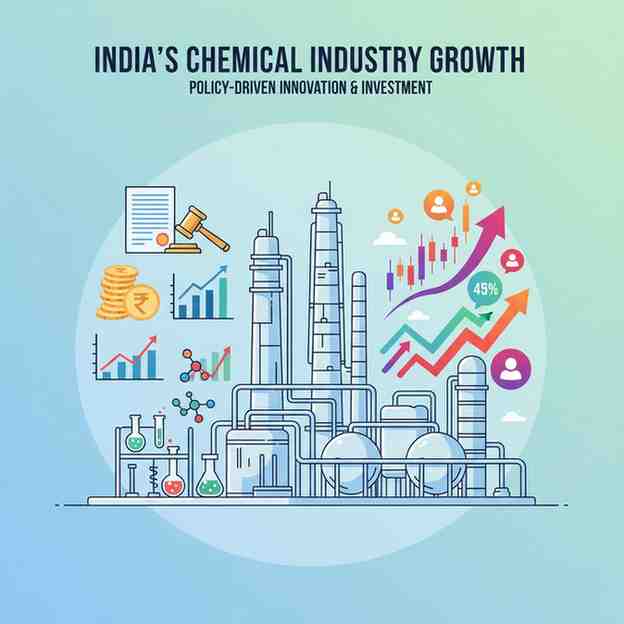
Role of Government Policies and PLI Schemes in Boosting Chemical Industry Stocks
Role of Government Policies and PLI Schemes in Boosting Chemical Industry Stocks
The Indian chemical industry is undergoing a period of structural transformation, driven by a combination of favorable government policies, increasing global demand, and strategic initiatives such as the Production Linked Incentive (PLI) scheme. Over the past few years, India’s focus on self-reliance, industrial competitiveness, and sustainable manufacturing has significantly influenced the trajectory of the chemical sector — and consequently, the performance of chemical industry stocks.
Thank you for reading this post, don't forget to subscribe!This article explores how policy-driven reforms and PLI incentives are shaping the future of India’s chemical industry, and how investors can interpret these developments when assessing the long-term potential of chemical sector stocks.
How PLI Schemes Are Driving Growth in India’s Chemical Industry
The PLI scheme for the chemical industry in India has been designed to attract large-scale investments, enhance domestic manufacturing capacity, and reduce dependence on imports. While the initial PLI phases focused on sectors like pharmaceuticals, electronics, and renewable energy, the government has gradually extended this model to cover specialty chemicals and related intermediates — a critical area where India holds strong growth potential.
Under the proposed Production Linked Incentive (PLI) scheme for specialty chemicals, companies are eligible for financial incentives based on incremental sales of eligible products manufactured in India. The focus is on high-value specialty and performance chemicals, including agrochemicals, API intermediates, and polymer additives. These segments not only serve domestic industries but also have significant export potential.
From an investor’s perspective, companies participating in the PLI scheme may benefit from higher production volumes, margin expansion, and enhanced competitiveness. As a result, chemical industry stocks benefiting from PLI incentives have witnessed renewed investor interest, supported by expectations of improved revenue visibility and policy stability.
Government Policy Support and Its Impact on Chemical Stocks
The impact of government policies on chemical sector growth extends well beyond the PLI framework. Fiscal measures, regulatory reforms, and targeted infrastructure development have collectively created an enabling environment for both domestic and foreign investors.
For instance, the government support for Indian chemical manufacturers includes rationalization of customs duties, introduction of single-window clearance systems, and dedicated industrial corridors such as Petroleum, Chemicals, and Petrochemicals Investment Regions (PCPIRs). These policy actions are aimed at reducing operational bottlenecks and promoting large-scale manufacturing ecosystems.
The role of fiscal and tax incentives in boosting chemical stocks cannot be understated. Reduced import duties on raw materials, corporate tax cuts for new manufacturing units, and subsidies for R&D and export-oriented production have all contributed to improved profitability metrics for listed chemical companies. Consequently, the stock performance of leading players in basic, specialty, and performance chemicals often mirrors the government’s policy direction and its execution efficiency.
Role of Atmanirbhar Bharat and Make in India in Strengthening the Chemical Sector
The twin initiatives of Atmanirbhar Bharat and Make in India have been pivotal in promoting self-reliance across critical sectors, including chemicals. These programs aim to strengthen domestic supply chains, encourage local manufacturing, and reduce dependency on imported intermediates — a vulnerability that became evident during global supply chain disruptions.
Under the Atmanirbhar Bharat vision, India is positioning itself as a global manufacturing hub for chemicals and intermediates. The government’s proactive approach to import substitution, coupled with strong export promotion policies, has created opportunities for manufacturers of specialty and green chemicals.
Moreover, government initiatives driving chemical sector growth in India have encouraged multinational corporations to establish joint ventures and production bases within the country. As global companies diversify away from China under the “China+1” strategy, India’s policy ecosystem offers a compelling alternative supported by fiscal incentives and policy continuity.
How Policy Reforms Are Creating Opportunities for Chemical Manufacturers
Recent policy reforms and regulatory improvements have simplified compliance procedures, accelerated approvals, and enhanced environmental governance — all of which contribute to sustainable industrial growth. The FDI and regulatory reforms in India’s chemical industry have allowed 100% foreign direct investment under the automatic route (except for hazardous chemicals), attracting significant inflows from Japan, Germany, and the U.S.
Additionally, the government has focused on policy measures supporting chemical exports and infrastructure, such as developing integrated chemical parks, upgrading logistics networks, and facilitating export-oriented clusters. These initiatives not only lower logistics and input costs but also improve the competitiveness of Indian manufacturers in global markets.
Another crucial area of focus is sustainability. Incentives for green and specialty chemical production reflect India’s long-term commitment to cleaner and more efficient manufacturing. Environmental compliance, resource efficiency, and adoption of renewable energy in production are being incentivized through tax benefits and preferential access to financing. These factors are expected to improve the global positioning of Indian companies, especially as international buyers increasingly prioritize ESG-compliant supply chains.
Impact of PLI Incentives on Specialty and Green Chemical Investments
The PLI incentives have been particularly significant for the specialty and green chemicals segments, which are witnessing rapid growth due to their application across sectors such as pharmaceuticals, electronics, textiles, and agriculture. These high-margin products are less cyclical than basic chemicals and are becoming a strategic focus for both large conglomerates and mid-cap chemical companies.
The market outlook for the chemical industry under the PLI scheme remains optimistic. Analysts expect the scheme to accelerate capacity expansion and technology adoption, enabling Indian firms to compete more effectively in global markets. This structural transformation is likely to translate into steady revenue growth and improved stock valuations for companies aligned with government initiatives.
As the government continues to roll out supportive frameworks — including environmental clearances, land acquisition reforms, and funding mechanisms for research and innovation — the industry is poised for sustained expansion. Over the medium term, this policy-backed momentum could strengthen investor confidence and attract long-term capital flows into the sector.
Policy-Driven Growth in India’s Chemical Sector: The Road Ahead
The policy-driven growth in India’s chemical sector is a reflection of strategic government intent to position the country as a key global player in chemical manufacturing and exports. The alignment of industrial policy, environmental sustainability goals, and investment incentives is gradually reshaping the sector’s growth profile.
Looking ahead, continued focus on government support for Indian chemical manufacturers, coupled with stable regulatory mechanisms and targeted incentives, will be crucial for maintaining momentum. For investors, the interplay between government policies and corporate performance offers a valuable framework for evaluating potential opportunities in chemical industry stocks benefiting from PLI incentives and related policy initiatives.
While policy implementation remains an ongoing challenge, the direction of reforms suggests a positive trajectory for India’s chemical ecosystem. With the right balance of fiscal discipline, environmental responsibility, and investment facilitation, the Indian chemical industry is well-positioned to sustain its growth momentum and contribute meaningfully to the broader manufacturing landscape.
Related Blogs:
The Role of Chemicals in Pharma and Biotech: Opportunities for Investors
Healthcare, Pharma, and Biotech Stocks: Building a Diversified Healthcare Portfolio in India
Indian Healthcare Ecosystem: Diversification Strategies Across Pharma, Biotech, and Allied Sectors
5 Best Chemical Stocks for Long-Term Investment in India
Top 5 Chemical Stocks in India
Best Chemical Stocks in India
Best Healthcare Stocks in India
How Pharma, Biotech, and Technology are Shaping Healthcare Investments in India
Diagnosis to Treatment: Investing in the Integrated Healthcare Value Chain in India
Top 5 Healthcare Stocks in India
Best Diagnostic Device Stocks in India
Top 5 Pharma Stocks in India
Top 5 Biotech Stocks in India
Best Diagnostic Device Stocks in India
The Rise of Point-of-Care Diagnostics: Impacts on Pharma, Biotech, and Investment Opportunities in India
Healthcare Investing: A Guide to Pharma, Biotech, and Related Stocks in India
Disclaimer: This blog post is intended for informational purposes only and should not be considered financial advice. The financial data presented is subject to change over time, and the securities mentioned are examples only and do not constitute investment recommendations. Always conduct thorough research and consult with a qualified financial advisor before making any investment decisions.

